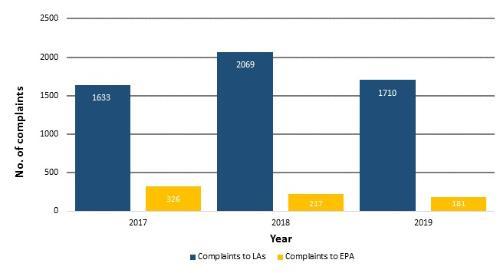Noise complaints
- Transport related noise complaints
- Industrial/commercial noise complaint
- Complaints & responsible authorities
In Ireland, noise complaints normally fall under four main categories:
- complaints about entertainment, such as loud music
- domestic/neighbourhood noise
- industrial/commercial activities that cause noise and
- transport-related noise sources.
If you have a noise complaint, take a look at the table below which shows the different noise categories and the authority responsible. More information on relevant legislation can be found here.
Here you can see the noise complaints received by local authorities and the EPA for the years 2017-2019. Most of the complaints about noise received by local authorities were from urban areas, with Dublin local authorities receiving the most complaints. Almost a third of all complaints received by the EPA, about EPA-licensed sites, related to noise issues.
Figure 4.4; General noise complaints received by local authorities and noise complaints received by the EPA about EPA-licensed sites (2017-2019)

Transport related noise complaints
Along with local authorities, Transport Infrastructure Ireland (TII) has the main responsibility for dealing with road- and rail-related noise complaints.
Noise complaints around Dublin Airport have become a more significant issue in recent years, with the Dublin Airport Authority (DAA) logging 15,160 noise-related complaints in 2019, compared to just 1,453 complaints in 2018. Most of the 2019 complaints were accounted for by two individuals who accounted for almost three quarters of all complaints logged by the DAA. In 2020, there has clearly been a major reduction in airport activities during the COVID-19 pandemic. Meanwhile, the numbers of passengers using Cork (2.4 million passengers) and Shannon (1.85 million passengers) Airports had also increased in recent years, until the Covid-19 pandemic largely grounded air travel during 2020.
The Airport Noise Competent Authority (ANCA) set up as a separate entity within Fingal County Council in 2019. This unit is responsible for ensuring that noise generated by aircraft activity at Dublin Airport is assessed in accordance with EU and Irish regulations. It ensures the application of the ‘balanced approach’ to aircraft noise management. However, it is not yet clear what role, if any that the ANCA will play in relation to noise complaints at the airport.
Industrial/commercial noise complaints
As part of the Integrated Pollution Prevention and Control (IPPC) and Waste Licensing systems, certain scheduled activities and operations have conditions attached to their licences which effect control over emissions of noise. Noise control measures and limits are generally stipulated by specific licensing conditions. Limits may be imposed at boundary positions and/or at noise sensitive locations. In addition, certain limits may be applied to specific sources of noise on-site. Typically licence conditions also place restrictions on tonal and impulsive characteristics associated with noise emissions from licensed facilities.
If a member of the public has a noise complaint about a licensed site, they should consider keeping a detailed record using the EPA Noise Log Sheet which they can then submit to the inspector for assessment.
Entertainment
| Example of Complaint Type | Responsible Authority |
|---|---|
|
Bars, nightclubs and restaurants |
|
|
Concerts and out-door events |
|
Domestic
| Example of Complaint Type | Responsible Authority |
|---|---|
|
Domestic noise such as parties or construction work |
|
Industrial/Commercial Activities
| Example of Complaint Type | Responsible Authority |
|---|---|
|
|
|
|
|
Transport
| Example of Complaint Type | Responsible Authority |
|---|---|
|
|
|
|
|
Other
| Example of Complaint Type | Responsible Authority |
|---|---|
| Crow gun, bangers, gun clubs |
|
| Barking dogs |
|
| Security alarms |
|
| Noise at work |
|
Section 108
The citizens information website has some useful information on noise nuisance. If a noise complaint cannot be resolved by your local authority or through local mediation, then there is an option for any person to seek a court order under section 108 of the Environmental Protection Agency Act 1992 to try to get their complaint resolved.